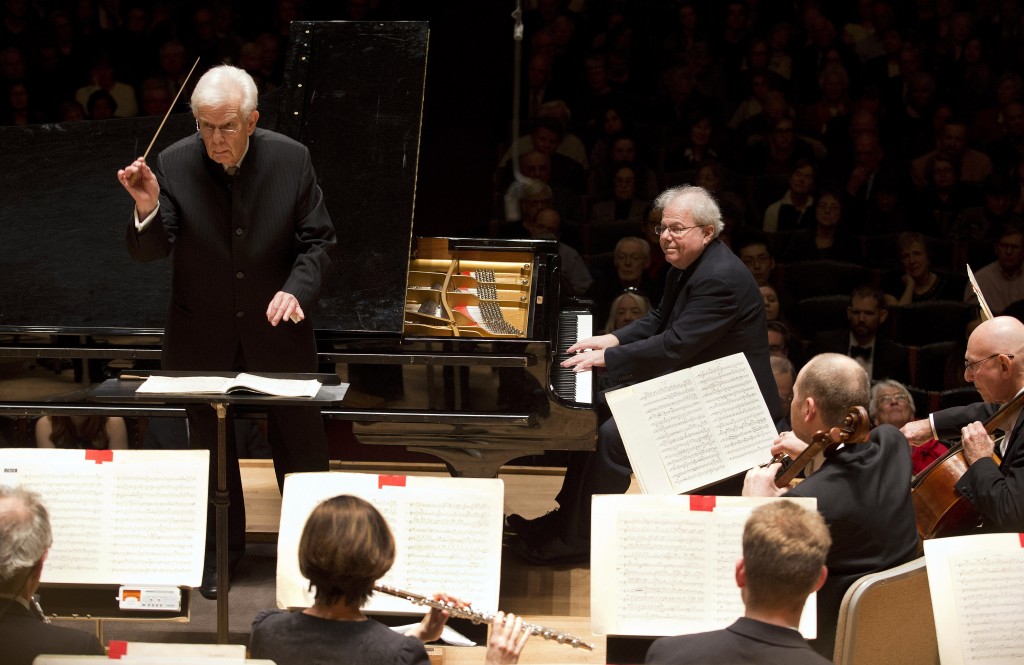Ax shines in Mozart-Strauss program with Dohnanyi, BSO

Emanuel Ax performed music of Mozart and Strauss Thursday night with the Boston Symphony Orchestra conducted by Christoph von Dohnanyi. Photo: Winston Towson
The Burleske in D minor for piano and orchestra is undoubtedly Richard Strauss’s first masterpiece. Written when the composer was only 21, the score, with its tangy, colorful orchestration, shows Strauss already at work with the same humorous touches and broad ideas that would come to characterize his later music. The piece, moreover, is fiendishly difficult for the pianist and was even deemed unplayable by Hans von Bülow when he first encountered it in 1886.
Yet its Lisztian, knuckle-busting cascades sounded effortless at Symphony Hall Thursday night when Emanuel Ax and the Boston Symphony Orchestra offered a glittering performance of the work as part of a Strauss and Mozart program led by Christoph von Dohnányi.
Ax possesses a crystalline technique and a gift for mining the drama from the music in his broad repertoire. And the Burleske, with its swirling melodies, dreamy passages, and electric bursts of energy, provided plenty of material for him to explore. He handled the crashing scale passages that pepper this score with aplomb. The orchestra answered him in kind with full, resplendent phrases.
The pianist was also able to mine a chamber-like delicacy from the music. Especially sensitive was his dialogue with the brilliant BSO timpanist Timothy Genis. The audience showed their appreciation for both musicians. Ax, after receiving his own rousing ovation, acknowledged Genis to loud cheers.
If the Burleske showed Ax’s fiery brilliance, then Mozart’s Piano Concerto No. 14 in E-flat, also heard Thursday evening, featured him in an intimate setting. Indeed, the trickling lines that fill this concerto are imbued with a characteristic grace that virtually define the term “Mozartean.”
Here too, Ax was in fine form, playing the first-movement filigree with delicacy. His tone took on a penetrating touch, the right-hand themes sounding with bell-tone clarity over the gently flowing accompaniment in his left. Full of sweet and arching melodies, the second movement was svelte due to Ax’s pearly tone and colorful dynamic shading. The finale, taken at a sure-footed tempo, was a little slow, but Ax’s soft touch enabled the music to still sound light on its feet. The coda, though, moved with sprightly energy.
The accompaniment that Dohnányi pulled from the orchestra was stately and stiff, which left room for the solo lines to sparkle but little else. The second movement fared best, with orchestra responding with warm, supple ensemble blend when called upon.
The most rewarding playing from the orchestra came with the final piece on the program, Mozart’s Symphony No. 35. Known as the “Haffner” Symphony, the work is one of the composer’s more dramatic essays for orchestra.
Dohnányi led a fluent and sparkling account, directing with gentle waving gestures that let the music speak for itself. The darting phrases of the first movement had bite and fiery energy, while the melodies of the second moved with fluid motion. The lilting minuet segued elegantly into the spirited finale. There, the orchestra’s playing lost some of its polish, but the musicians still managed to put across the music with boisterous energy.
The concert opened with the memorable Sextet from Strauss’s Capriccio, played by violinists Malcolm Lowe and Haldan Martinson, violists Steven Ansell and Cathy Basrak, and cellists Jules Eskin and Mihail Jojatu. Their reading was full of arresting beauty, the music unfolding in sheets of glowing sound. The ensemble took time to bring out the darkness and light from Strauss’ score, with each musician weaving rich lines into a shimmering tapestry.
The program will repeat 1:30 p.m. Friday and 8 p.m. Saturday and Tuesday at Symphony Hall. bso.org
Posted in Performances




